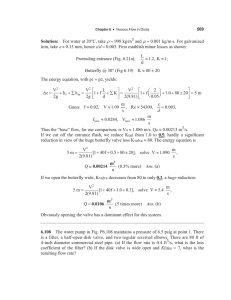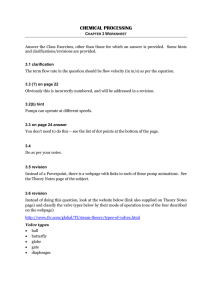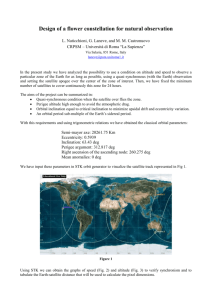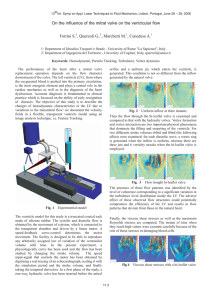Document 12908553
advertisement
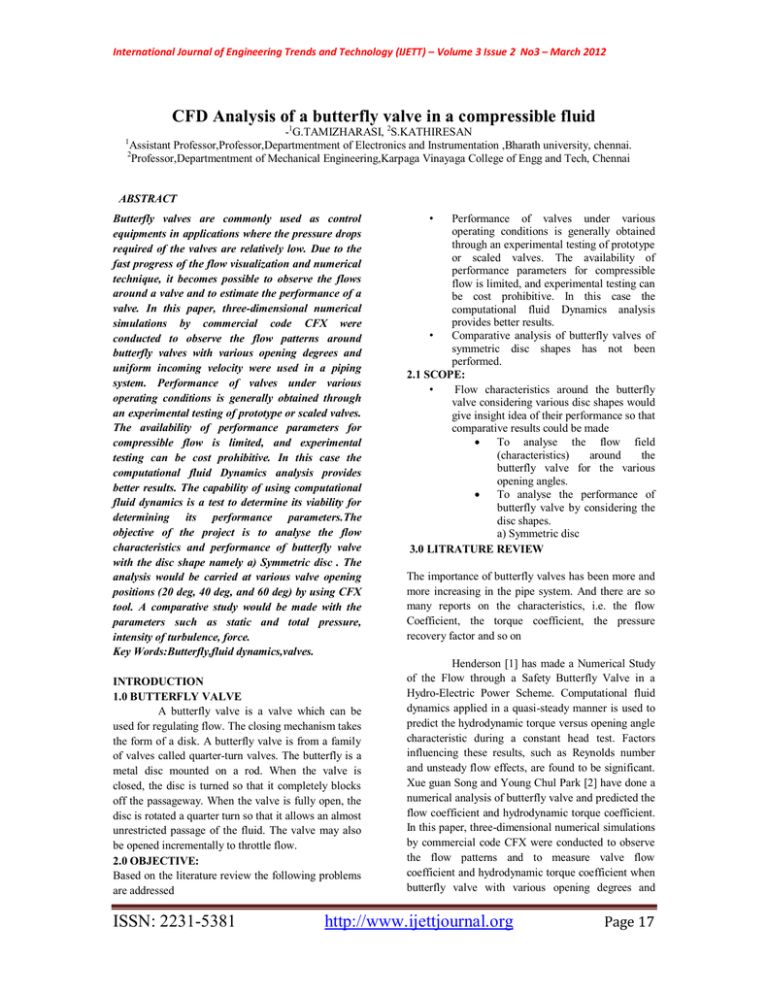
International Journal of Engineering Trends and Technology (IJETT) – Volume 3 Issue 2 No3 – March 2012 CFD Analysis of a butterfly valve in a compressible fluid -1G.TAMIZHARASI, 2S.KATHIRESAN Assistant Professor,Professor,Departmentment of Electronics and Instrumentation ,Bharath university, chennai. 2 Professor,Departmentment of Mechanical Engineering,Karpaga Vinayaga College of Engg and Tech, Chennai 1 ABSTRACT Butterfly valves are commonly used as control equipments in applications where the pressure drops required of the valves are relatively low. Due to the fast progress of the flow visualization and numerical technique, it becomes possible to observe the flows around a valve and to estimate the performance of a valve. In this paper, three-dimensional numerical simulations by commercial code CFX were conducted to observe the flow patterns around butterfly valves with various opening degrees and uniform incoming velocity were used in a piping system. Performance of valves under various operating conditions is generally obtained through an experimental testing of prototype or scaled valves. The availability of performance parameters for compressible flow is limited, and experimental testing can be cost prohibitive. In this case the computational fluid Dynamics analysis provides better results. The capability of using computational fluid dynamics is a test to determine its viability for determining its performance parameters.The objective of the project is to analyse the flow characteristics and performance of butterfly valve with the disc shape namely a) Symmetric disc . The analysis would be carried at various valve opening positions (20 deg, 40 deg, and 60 deg) by using CFX tool. A comparative study would be made with the parameters such as static and total pressure, intensity of turbulence, force. Key Words:Butterfly,fluid dynamics,valves. INTRODUCTION 1.0 BUTTERFLY VALVE A butterfly valve is a valve which can be used for regulating flow. The closing mechanism takes the form of a disk. A butterfly valve is from a family of valves called quarter-turn valves. The butterfly is a metal disc mounted on a rod. When the valve is closed, the disc is turned so that it completely blocks off the passageway. When the valve is fully open, the disc is rotated a quarter turn so that it allows an almost unrestricted passage of the fluid. The valve may also be opened incrementally to throttle flow. 2.0 OBJECTIVE: Based on the literature review the following problems are addressed ISSN: 2231-5381 • Performance of valves under various operating conditions is generally obtained through an experimental testing of prototype or scaled valves. The availability of performance parameters for compressible flow is limited, and experimental testing can be cost prohibitive. In this case the computational fluid Dynamics analysis provides better results. • Comparative analysis of butterfly valves of symmetric disc shapes has not been performed. 2.1 SCOPE: • Flow characteristics around the butterfly valve considering various disc shapes would give insight idea of their performance so that comparative results could be made To analyse the flow field (characteristics) around the butterfly valve for the various opening angles. To analyse the performance of butterfly valve by considering the disc shapes. a) Symmetric disc 3.0 LITRATURE REVIEW The importance of butterfly valves has been more and more increasing in the pipe system. And there are so many reports on the characteristics, i.e. the flow Coefficient, the torque coefficient, the pressure recovery factor and so on Henderson [1] has made a Numerical Study of the Flow through a Safety Butterfly Valve in a Hydro-Electric Power Scheme. Computational fluid dynamics applied in a quasi-steady manner is used to predict the hydrodynamic torque versus opening angle characteristic during a constant head test. Factors influencing these results, such as Reynolds number and unsteady flow effects, are found to be significant. Xue guan Song and Young Chul Park [2] have done a numerical analysis of butterfly valve and predicted the flow coefficient and hydrodynamic torque coefficient. In this paper, three-dimensional numerical simulations by commercial code CFX were conducted to observe the flow patterns and to measure valve flow coefficient and hydrodynamic torque coefficient when butterfly valve with various opening degrees and http://www.ijettjournal.org Page 17 International Journal of Engineering Trends and Technology (IJETT) – Volume 3 Issue 2 No3 – March 2012 uniform incoming velocity were used in a piping system. Zachary Leutwyler and Charles Dalton [3] have done a CFD Study of the Flow Field, Resultant Force, and Aerodynamic Torque on a Symmetric Disk Butterfly Valve in a Compressible Fluid is a test to determine its viability for determining performance coefficients. Kerh [4] performed an analysis of the butterfly valve on the basis of the experimental results. Sarpkara [5] theoretically treated the characteristics of a flat butterfly valve. Kimura and Tanaka [6] studied the pressure loss characteristics theoretically for a practical butterfly valve and so on. With the development of the Computational Fluid Dynamics (CFD), the approach of using the technique of computational fluid dynamics has been studied. Huang and Kim [7] performed a three-dimensional numerical flow visualization of incompressible flows around the butterfly valve 4.0 BASICS OF COMPUTATIONAL FLUID DYNAMICS 4.1 Introduction CFD provides numerical approximation to the equations that govern fluid motion. Application of the CFD to analyze a fluid problem requires the following steps. First, the mathematical equations describing the fluid flow are written.. 5.0CFD TOOL – ANSYS CFX 5.1 INTRODUCTION CFX is a commercial Computational Fluid Dynamics (CFD) program, used to simulate fluid flow in a variety of applications. The ANSYS CFX product allows engineers to test systems in a virtual environment. The scalable program has been applied to the simulation of water flowing past ship hulls, gas turbine engines (including the compressors, combustion chamber, turbines and afterburners), aircraft aerodynamics, pumps, fans, HVAC systems, mixing vessels, hydro cyclones, vacuum cleaners etc. 6.0CFD ANALYSIS, MODELLING AND MESH CREATION 6.1 MODELING This is the initial step in analysis process. The primary purpose of geometry creation is to generate a solid that defines region for fluid flow. This section describes creation of geometry. Dimensions and geometry details of existing model was collected. Modeling was done using Pro E Wild Fire 2.0 and exported in IGES format. The model of symmetric disc shape has been shown in the following figure ISSN: 2231-5381 Figure 1 Symmetric Disc Fig 2 (a) 20 deg Inclination Fig 2 (b) 40 deg Inclination Fig 2 (c) 60 deg Inclination 6.2 CREATING REGIONS AND MESHING This step defines creation of regions and geometry. 2D region is created for defining inlet and outlet. Creation of regions facilitates to assign boundary condition for inlet, outlet and other defined regions. http://www.ijettjournal.org Page 18 International Journal of Engineering Trends and Technology (IJETT) – Volume 3 Issue 2 No3 – March 2012 Fig 3 (a) 20 deg Inclination Fig.3 (b) 40 deg Inclination Fig .4 (b) 40 deg Inclination Fig 3 (c) 60 deg Inclination Fig 3 Meshed Model Element type : Tetrahedron Global Element Factor : 2 Mesh Type : Volume mesh Number of Nodes : 157537 Number of elements : 935614 6.3 SPECIFICATION OF DOMAIN AND BOUNDARY CONDITIONS 6.3.1 Global Domain Specification Domain : Fluid Domain Fluid : Air Heat Transfer Model : Thermal Energy Turbulence Model : k epsilon Domain : Solid Domain Material : Steel Heat Transfer Model : Thermal Energy Fig 4 (c) 60 deg Inclination Fig 4 Computational Domain 6.3.2 Boundary Conditions 6.3.2.1 Inlet Boundary Conditions for Air Inlet Flow Direction = Normal to Boundary Flow Regime = Subsonic Heat Transfer = Static Temperature Static Temperature = 40 [C] Static Pressure = 1.4 [bar] Turbulence = Medium Intensity 7.3.2.2 Wall Boundary Conditions Heat Transfer = Adiabatic Wall Influence on Flow = No Slip Wall Roughness = Smooth Wall 6.4 SOLVER STAGE After defining all the conditions the model is imported in CFX- Solver Module for doing iterative calculations and to generate result file. The following solver control parameters have been specified in CFX- Pre Module. 6.4.1 Solver Control parameters Number of iterations: 150 Time scale control : Auto Time scale Residual Target : 7.0 RESULTS AND DISCUSSION Pressure distribution Fig.4(a)20degInclination ISSN: 2231-5381 http://www.ijettjournal.org Page 19 International Journal of Engineering Trends and Technology (IJETT) – Volume 3 Issue 2 No3 – March 2012 Fig 5(a) 20 deg Inclination Fig Fig5(b) 40 deg Inclination Fig 5(c) 60 deg Inclination Fig 5 Pressure distribution across the various valve opening positions Fig 5 shows the pressure distribution across the valve for the 20 deg, 40 deg and 60deg opening positions. The pressure drop observed in the flow at downstream immediately after the valve for 40deg and 60 deg opening position which is significantly high in latter case. In the case of 20deg (Fig 5 (a)) opening position comparatively reduced drop in pressure has been observed at downstream. It is also observed from the results that pressure rise at the face of the valve is less in the case of 20deg opening position Total Pressure distribution stagnation pressure (total pressure) variation in flow creates wake region. Uniform stagnation pressure distribution in the flow is generally desirable. The stagnation pressure in the flow decreases immediately at rear face of the valve and it continues along its flow stream. The increased stagnation pressure loss is observed in the case of 60deg (fig 6 (c)) opening position. Turbulence Kinetic Energy Fig 7(a) 20 deg Inclination Fig 7(b) 40 deg Inclination Fig 7(c) 60 deg Inclination Fig 7Turbulence kinetic energy across the various valve opening positions Fig 7 shows turbulence kinetic energy variation along the flow. The turbulence kinetic energy refers intensity of turbulence in the flow. More the turbulence causes energy loss in the flow. The turbulence level is quite increased at the flow downstream for all cases and it is significantly high in the case of 40 deg (fig 7 (b)) opening position. Force on the valve body Fig 6(a) 20 deg Inclination Fig 6(b) 40 deg Inclination Fig 6(c) 60 deg Inclination Fig 6 Total pressure distribution across the various valve opening positions Fig 6 shows total pressure distribution along the flow for various valve opening positions. Generally ISSN: 2231-5381 Fig 8(a) 20 deg Inclination http://www.ijettjournal.org Page 20 International Journal of Engineering Trends and Technology (IJETT) – Volume 3 Issue 2 No3 – March 2012 Fig 8.(b) 40 deg Inclination Fig 8(c) 60 deg Inclination Fig 8 Intensity of fluid force on the valve surface Fig 8 shows Intensity of fluid force on the valve surface. The results show that force concentration on the valve surfaces. The increased force concentration has been observed for 40deg (fig 8 (b)) opening position. It is relatively reduced in the case of 60deg (fig 8 (c) opening position. structure interaction in a controlvalve,Journal of Fluid Engineering,(1996)), [7]Kimura T. and Tanaka T, Hydrodynamic characteristics of a butterfly valve-Prediction of pressure loss characteristic, ISA Transactions (1995), 319-326 [8]Lin F. and Schohl G. A., CFD prediction and validation of butterfly valve hydrodynamic force, WorldwaterCongress(2004} [9] Sarpkara T., Torque and cavitation characteristics of butterfly valve, ASME Journalof Appplied Mechanics (1961), 511-518 [10] Xue guan Song, Young Chul Park, Numerical analysis of butterfly valve-prediction of flow coefficient and hydrodynamic torque coefficient Proceedings of the World congress on Engineering and Computer Science (2007) 8.0CONCLUSION Thus CFD analysis of symmetric disc valve has been carried out and following conclusion has been drawn At smaller opening angle the pressure loss is comparatively less. The total pressure variation and the intensity of turbulence increase at downstream when opening angle increases. Force concentration has been observed for 40 deg valve opening position. Increased wall shear has been observed for 40 and 60 deg opening positions. REFERENCE [1] Chern M. J. and Wang C. C, Control of volumetric flow-Rate of ball valve using V-port, Journal of Fluid Engineering (2004), 471-481 [2] Henderson A. D. , Sargison J. E. , A Numerical Study of the Flow through a Safety Butterfly Valve in a Hydro-Electric Power Scheme 16th Australasian Fluid Mechanics Conference (2007) 1116 -1121 [3] Huang C.D. and Kim R.H, Three-dimensional analysis of partially open butterfly valve flows, Transactions of the ASME, (1996), 562-568 [4] John David Anderson, Computational Fluid Dynamics: The Basics with Applications,McGrawHill(1995) [5] Kalsi M. S. , EldiWany B., Effect of Butterfly Valve Disc Shape Variations on Torque Requirements for power plant Applications, Kalsi Engineering Inc [6] Kerl, T., Lee .J and Wellford L. C, Transient fluid- ISSN: 2231-5381 http://www.ijettjournal.org Page 21
